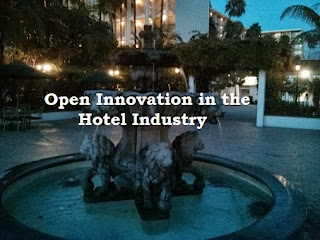 |
| Town and Country Resort-San Diego |
Innovation is increasingly seen as one method of
improving upon the economic fundamentals within industries. As businesses
develop new products and services they become more competitive and able to
succeed in a highly competitive global environment. Research by Artic (2013)
helps shed light on the potential for open innovation and economic improvement
of the hard hit hotel industry in Slovenia. Their findings highlight potential
uses of open innovation in meeting customer needs and expectations.
The author separates innovative societies from
non-innovative societies. Innovative societies are those that seek to enhance
their markets by developing new products and services that in turn can
influence jobs and economics. Routine societies try and maintain existing
systems without creative destruction whereby economic growth
become stagnant. Stagnation means eventual decline as other countries zoom to
fill market gaps.
Open innovation is defined by Chesbrough (2003, pg.
12) as, “a model that assumes that
companies can improve their business to use external and internal ideas, and
the internal and external paths to market, which will contribute to their
development”. This process occurs
when participants, whether corporate or individual, brings forward ideas and
technology to increase the value added nature of products/services. These
improved products/services make companies more competitive in the global
marketplace.
According to Sloane (2011), open innovation reduces
costs, improves productivity, generates innovative ideas and reduces the time
it takes to put new products on the market. In the hotel industry, open innovation
solicits ideas from both customers as well as other industry stakeholders to
improve upon the overall development of the industry. The ideas and suggestions
are used to develop better services and service management to raise the value
of the hotel experience.
The author contends that open innovation seeks to
foster synergy of stakeholders, resources, and competitive advantage.
Stakeholders are seen as suppliers, related businesses, inventors, etc. while
resources are generally seen as knowledge and information. Competitive
advantage is fostered as new products and services hit the market at a faster
rate thereby maximizing profits.
The researcher used 35 Slovenian hotels in an
attempt to understand the hotels understandings of their demographics, the macroeconomic
environment and open innovation. The found that 63% of participants believe
that entrepreneurship and globalization dictate trends of development, 75% that
innovation is a major developmental force and 75% believe that it will be even
more important in the future to understand the needs of guests. Only 38% of
hotel administrators heard of the concept of open innovation but more than half
were sure they were using it.
The author’s study focused on open innovation
awareness and use in the Slovenian hotel industry. The study was limited to
customers alone. There are other factors of open innovation which could include
cross-industry use for major product/service development, supplier collaboration
for transactional efficiency, governmental usage for community building in
addition to customer usage. The study does highlight how open innovation can
increase the competitive stance of companies by encouraging new product/service
development as well as reduce time to bring those products/services to market.
Artic, N. (2013). Open innovation as a chance to
overcome economic crisis in hotel industry. Tourism
in South East Europe, 2.
Chesbrough, H. (2003). The era of open innovation. MIT
Sloan Management Review, 44 (3). pp.
35-41.
Sloane, P. (2011). The brave new world of open
innovation. Strategic Direction, 27
(5), pp. 3-4.